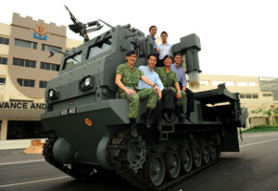MANY DISCIPLINES, ONE TEAM
PHOTO // Chua Soon Lye
The brief was simple: Build a safe, speedy and efficient mine-clearing vehicle for the Army. However, the actual development of the Trailblazer was a journey fraught with challenges, said the design team.
With no predecessor vehicle to model after, the Trailblazer team had to tap the experience and expertise of its members, who came from the Defence Science & Technology Agency (DSTA), the Army and Singapore Technologies Kinetics (ST Kinetics).
Said team leader Roger Lim: "It's a multi-disciplinary team comprising different people within DSTA - not just the mechanical engineers, electrical engineers and software engineers, but also the reliability and testing engineers." Mr Lim is DSTA's Programme Manager for Land Systems.
He also described the collaboration of DSTA, the Army and ST Kinetics as "a unique tripartite relationship". Input from the military as the end-user was helpful in shaping both the aesthetic attributes and technical composition of the Trailblazer, while the expertise of staff at ST Kinetics enabled new innovations and capabilities to be incorporated.
Mr Lim added: "Our inspiration for the Trailblazer didn't come overnight. It took us a lot of time and resource to arrive at the best solution, from an engineering viewpoint."
The team went on overseas study trips, spoke to foreign armies and conducted intensive research before they could see their ideas materialise.
The journey has been long, and Mr Lim confessed that there were several tense moments among team members due to the technical challenges, schedule delays and so on. "But we understood that everybody had a different role...and we had to really focus on what was important to the project, put aside our differences, agree to disagree and give our best to make sure that this project could move on," he added.
The Trailblazer, which boasts a state-of-the-art transmission that allows it to move at 0.25kmh at its slowest and up to 50kmh at its fastest, was awarded the 2009 Team Defence Technology Prize for Engineering.
Elaborating on this, Lieutenant Colonel (LTC) Roy Foo, who led the Army component of the project team, explained that other systems would typically require two types of engines - one for low speed, one for high. But the Trailblazer team had developed a "two-in-one engine" that enabled the vehicle to move at either of the two extreme speeds - something he described as a "technological breakthrough".
LTC Foo is also the Commanding Officer of the 38th Battalion, Singapore Combat Engineers.
For the team, seeing their ideas come to fruition was the most rewarding part of the project. Said Mr Lim: "This was not a concept by an armchair scientist, but a real outcome. We could see the equipment, a new capability being delivered to the user. That was most satisfying for us."










